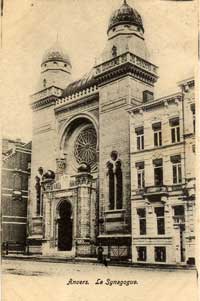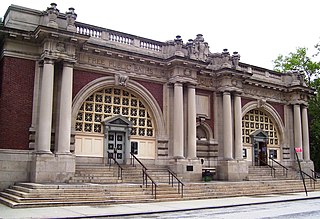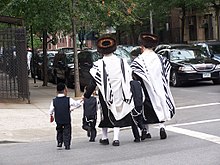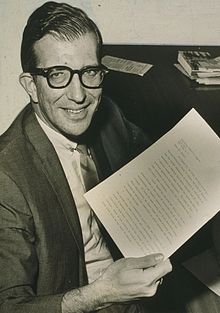
Chabad, also known as Lubavitch, Habad and Chabad-Lubavitch, is a dynasty in Hasidic Judaism. Belonging to the Haredi (ultra-Orthodox) branch of Orthodox Judaism, it is one of the world's best-known Hasidic movements, as well as one of the largest Jewish religious organizations. Unlike most Haredi groups, which are self-segregating, Chabad mainly operates in the wider world and caters to nonobservant Jews.

Yosef YitzchakSchneersohn was an Orthodox rabbi and the sixth Rebbe of the Chabad Lubavitch Hasidic movement. He is also known as the Frierdiker Rebbe, the Rebbe RaYYaTz, or the Rebbe Rayatz. After many years of fighting to keep Orthodox Judaism alive from within the Soviet Union, he was forced to leave; he continued to conduct the struggle from Latvia, and then Poland, and eventually the United States, where he spent the last ten years of his life.

Satmar is a group in Hasidic Judaism founded in 1905 by Grand Rebbe Joel Teitelbaum (1887–1979), in the city of Szatmárnémeti, Hungary. The group is a branch of the Sighet Hasidic dynasty. Following World War II, it was re-established in New York and has since grown to become one of the largest Hasidic dynasties in the world, comprising around 26,000 households.

Borough Park is a neighborhood in the southwestern part of the borough of Brooklyn, in New York City. The neighborhood is bordered by Bensonhurst to the south, Dyker Heights to the southwest, Sunset Park to the west, Kensington and Green-Wood Cemetery to the northeast, Flatbush to the east, and Mapleton to the southeast.

Crown Heights is a neighborhood in the central portion of the New York City borough of Brooklyn. Crown Heights is bounded by Washington Avenue to the west, Atlantic Avenue to the north, Ralph Avenue to the east, and Empire Boulevard/East New York Avenue to the south. It is about one mile (1.6 km) wide and two miles (3.2 km) long. Neighborhoods bordering Crown Heights include Prospect Heights to the west, Flatbush and Prospect Lefferts Gardens to the south, Brownsville to the east, and Bedford–Stuyvesant to the north.

Williamsburg is a neighborhood in the New York City borough of Brooklyn, bordered by Greenpoint to the north; Bedford–Stuyvesant to the south; Bushwick and East Williamsburg to the east; and the East River to the west. It was an independent city until 1855, when it was annexed by Brooklyn; at that time, the spelling was changed from Williamsburgh to Williamsburg.

The Crown Heights riot was a race riot that took place from August 19 to August 21, 1991, in the Crown Heights section of Brooklyn, New York City. Black residents attacked Orthodox Jewish residents, damaged their homes, and looted businesses. The riots began on August 19, 1991, after two 7 year-old children of Guyanese immigrants were unintentionally struck by a driver running a red light while following the motorcade of Rebbe Menachem Mendel Schneerson, the leader of Chabad, a Jewish religious movement. One child died and the second was severely injured.

Belz is a Hasidic dynasty founded in the town of Belz in Western Ukraine, near the Polish border, historically the Crown of the Kingdom of Poland. The group was founded in the early 19th century by Rabbi Shalom Rokeach, also known as the Sar Shalom, and led by his son, Rabbi Yehoshua Rokeach, and grandson, Rabbi Yissachar Dov, and great-grandson, Rabbi Aharon, before the Nazi invasion of Poland in 1939. While Aharon managed to escape Europe, together with his brother Rabbi Mordechai Rokeach, most of the Belz Hasidim were murdered in the Holocaust. Aharon re-established the Hasidic community in Israel following World War II. As of the 2020s, Belz has sizable communities in Israel, Western Europe, and the Anglosphere.

Munkatch Hasidism is a Hasidic sect within Haredi Judaism of mostly Hungarian Hasidic Jews. It was founded and led by Polish-born Grand Rebbe Shlomo Spira, who was the rabbi of the town of Strzyżów (1858–1882) and Munkacs (1882–1893). Members of the congregation are mainly referred to as Munkacs Hasidim, or Munkatcher Hasidim. It is named after the Hungarian town in which it was established, Munkatsh.

Skver is a Chasidic dynasty founded by Rebbe Yitzchok Twersky in the city of Skver, or Skvyra, in present-day Ukraine during the mid-19th century. Adherents of the rebbes of Skver are known as Skverer Hasidim.
Eliezer Zusia Portugal was the first Rebbe of Skulen. He was revered by his followers in Russia, Romania, Israel, and the United States for his personal warmth and his care for hundreds of Jewish youth and war orphans, whom he personally adopted as his own children. He established the Skulener dynasty in America in the 1960s. His only biological son, Rabbi Yisroel Avrohom Portugal, succeeded him as Rebbe.
The demographics of Brooklyn reveal a very diverse borough of New York City and a melting pot for many cultures, like the city itself. Since 2010, the population of Brooklyn was estimated by the Census Bureau to have increased 3.5% to 2,592,149 as of 2013, representing 30.8% of New York City's population, 33.5% of Long Island's population, and 13.2% of New York State's population. If the boroughs of New York City were separate cities, Brooklyn would be the third largest city in the United States after Los Angeles and Chicago.

The history of the Jews in Antwerp, a major city in the modern country of Belgium, goes back at least eight hundred years. Jewish life was first recorded in the city in the High Middle Ages. While the Jewish population grew and waned over the centuries, by the beginning of World War II Antwerp had a thriving Jewish community comprising some 35,000, with many Jews connected to the city's diamond industry. The Nazi occupation of Antwerp from 1940 and The Holocaust decimated the city’s Jewish population. By the time of Antwerp's liberation in September 1944, the Jewish population had fallen to around 1,200.

Yaakov Perlow was an American Hasidic rabbi and rosh yeshiva, and Rebbe of the Novominsk Hasidic dynasty. From 1998 until his death in 2020, he was president of Agudath Israel of America, a Haredi advocacy organization. He was also head of that organization's Moetzes Gedolei HaTorah. He was one of the most respected leaders of the American Orthodox Jewish community, known for his scholarly and oratorical skills.
Machon Chana is a private religious college for Jewish women affiliated with the Chabad Hasidic movement and geared toward Baalot Teshuva – women from secular backgrounds who become more observant. The school is located in the Crown Heights neighborhood of Brooklyn, New York.

Jews comprise approximately 10% of New York City's population, making the Jewish community the largest in the world outside of Israel. As of 2020, over 960,000 Jews lived in the five boroughs of New York City, and over 1.9 million Jews lived in the New York metropolitan area, approximately 25% of the American Jewish population.

Asser Levy, also known as Asser Levy van Swellem and Asher Levy, was one of the first Jewish settlers of the Dutch colony of New Amsterdam on Manhattan Island.

Jews in Los Angeles comprise approximately 17.5 percent of the city's population, and 7% of the county's population, making the Jewish community the largest in the world outside of New York City and Israel. As of 2015, over 700,000 Jews live in the County of Los Angeles, and 1.232 million Jews live in California overall. Jews have immigrated to Los Angeles since it was part of the Mexican state of Alta California, but most notably beginning at the end of the 19th century to the present day. The Jewish population rose from about 2,500 in 1900 to at least 700,000 in 2015. The large Jewish population has led to a significant impact on the culture of Los Angeles. The Jewish population of Los Angeles has seen a sharp increase in the past several decades, owing to internal migration of Jews from the East Coast, as well as immigration from Israel, France, the former Soviet Union, the UK, South Africa, and Latin America, and also due to the high birth rate of the Hasidic and Orthodox communities who comprise about 10% of the community's population.

The Jewish community of the Greater Cleveland area comprises a significant ethnoreligious population of the U.S. State of Ohio. Jews from Bavaria immigrated in the 1830s and its size has significantly grown in the decades since then. In the early 21st century, Ohio's census data reported over 150,000 Jews, with the Cleveland area being home to more than 50% of this population. As of 2018, Greater Cleveland is the 23rd largest Jewish community in the United States. As of 2023, the Cleveland Jewish Community is estimated to be about 100,000 people.
Dutch people have had a continuous presence in New York City for nearly 400 years, being the earliest European settlers. New York City traces its origins to a trading post founded on the southern tip of Manhattan Island by colonists from the Dutch Republic in 1624. The settlement was named New Amsterdam in 1626 and was chartered as a city in 1653. Because of the history of Dutch colonization, Dutch culture, politics, law, architecture, and language played a formative role in the shaping of New York City culture. The Dutch were the majority in New York City until the early 1700s, and the Dutch language was commonly spoken until the mid to late-1700s.






















